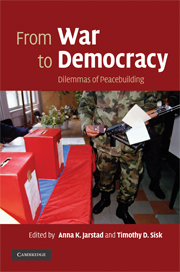Introduction
Published online by Cambridge University Press: 14 May 2010
Summary
Introducing democracy in the wake of civil war raises a stark question: How can societies shattered by war, with all the deep social enmity, personal suffering, and economic devastation that war brings, simultaneously move toward peace and democracy when competitive politics and hard-fought elections exacerbate social and political conflict? This book explores this question from two somewhat disparate strands of scholarly research: democratic transition theory and practice, which emphasizes, in the move from authoritarian rule to more democratic politics, elite-negotiated democratization pacts, popular mobilization, political party transformation, constitution making, electoral design, and resurrection of civil society; and theory and practice of post-war peacebuilding, with its emphasis on the elite and public negotiation of comprehensive peace agreements, the search for security through cease-fires, demobilization of armed forces, inclusion and reconciliation, external security guarantees, and long-term conflict transformation.
Introducing democracy in the wake of war has become a standard practice: since the 1990s, democratization is an integral part of international peacebuilding missions in the wake of civil war. Democracy and peace – two often-desired goals – are promoted in war-torn societies shattered by war. However, today's headlines – from Afghanistan, Kosovo, Nepal, and the Democratic Republic of Congo (DRC) to name but a few – reflect the evident dilemmas of war-to-democracy transitions. In these and other cases, democracy and peace do not always move forward hand in hand: sometimes, advances in democratization threaten peace, and the compromises necessary for peace restrict or defer democratization.
- Type
- Chapter
- Information
- From War to DemocracyDilemmas of Peacebuilding, pp. 1 - 14Publisher: Cambridge University PressPrint publication year: 2008
- 5
- Cited by

